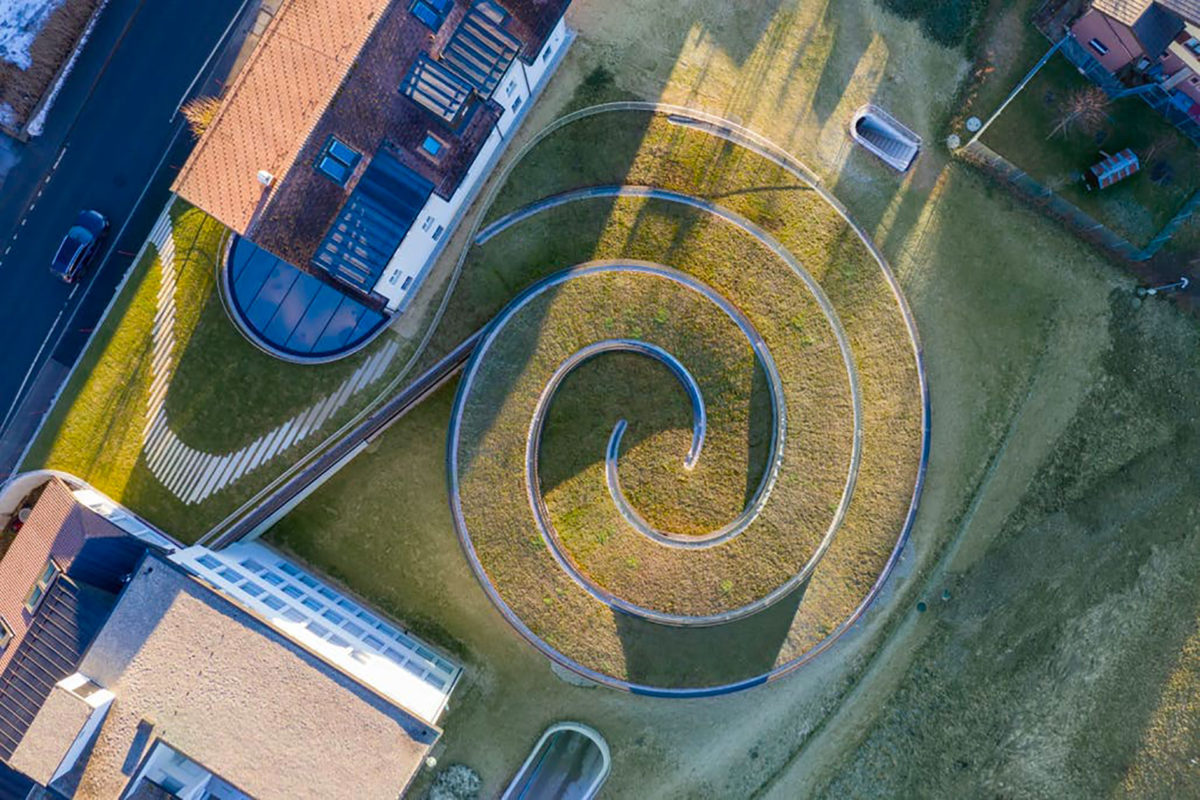The museum opened in June 2020 was designed by BIG studio as an extension of the historic headquarters of the famous Swiss wristwatch manufacturer Audemars Piguet
The Suisse Musée Atelier
Opened in June 2020, the Musée Atelier is located in Le Brassus, a village of the Vallée de Joux in the Swiss Jura. This is the historical location where the company of the luxury watch brand Audemars Piguet was established over 140 years ago. As a result, the venue unites contemporary architecture and traditional savoir-faire, expressing the blend of tradition and forward-thinking.
Indeed, the Musée Atelier links the original house where Jules Louis Audemars and Edward Auguste Piguet set business in 1875 – technically a start-up of the old times – to a glass spiral-shaped pavilion designed by Bjarke Ingels Group (Big) and realized by the Swiss architecture office CCHE in collaboration with the scenography specialist Atelier Brückner. Le Brassus will also host the new Hôtel des Horlogers, which will open in the summer of 2021, designed by BIG with CCHE.
Resulting from an architecture and museography competition launched in 2013, the Musée Atelier Audemars Piguet required seven years of development. More than a thousand people – including architects, engineers, and local artisans – have shared their craft, collaborating on creating this venue. Situated in this contemporary glass building, the leading exhibition presents three hundred timepieces spanning over two hundred years of watchmaking history in Switzerland.
Engineering meets design
This spiral Pavillon rises on walls of curved structural glass, being the first one of this kind to be built at such altitude. The construction also represents a studied combination of engineering and design. For instance, the steel roof covered with grass helps regulate temperature while absorbing water and reminds the mechanism inside a watch.
The glass – which counts 108 structural panes – allows visitors to admire the outside scenery. Also, a brass mesh runs along the external surface to regulate light and temperature. The floor, instead, adapts to the natural gradient of the land. In this way, the spiral-shaped building is perfectly embedded in the surrounding landscape.
The museum path converges clockwise towards the spiral’s center, following the curved glass walls before entering the opposite direction. Optically, flowing transitions characterize the path: the overall impression changes depending on the time of day and the season. Apart from glass, defining materials are brass, bleached ash, and glossy black lacquer as a surface coating.

A time-musical path
To offer visitors a diverse experience with crescendos, high points, and contemplative moments, German scenographer Atelier Brückner imagined the exhibition’s composition as a musical score. Interludes, including sculptures, automata, kinetic installations, and mock-ups of intricate mechanical movements, give life and rhythm to various aspects of horological technique and design.
Also, visitors are invited to try their hand at some of the ancestral techniques perpetuated by Audemars Piguet’s finishing experts, such as satin brushing and circular graining. The visit culminates at the center of the spiral with the display of Grandes Complications.
Inspired by the solar system, the spherical showcases orbit around the Universelle (1899), one of Audemars Piguet’s most complicated watches ever produced. Then, the watch exhibition ends with a rich collection of Royal Oak, Royal Oak Offshore, and Royal Oak Concept models.
During the path is also possible to admire special pieces like the ten examples of Audemars Piguet’s vintage chronograph, which are among the rarest in the world with a total production of only 307 units before 1980. Or, the watch for Naser al-Din Shah Qajar, King of Persia (1848–1896), remembered as a promoter of modernity in his country.
Legacy and craftsmanship
Conceived as a space of live crafts, the Musée Atelier brings visitors in close contact with the Manufacture’s artisans and watchmakers through three specialized ateliers situated at the heart of the spiral.
The first one is dedicated to the Grandes Complications, where each watch composed of more than 648 components spends from six to eight months in the hands of a single watchmaker before leaving the workshop. At present, this atelier counts twelve specialized craftspeople.
The second workshop hosts the Métiers d’Art, where Haute Joaillerie creations are conceived and crafted by highly skilled jewelers, gem-setters, and engravers. There, craftspeople face the landscape of the Vallée de Joux during their work.
The third one is dedicated to Restoration. In the workshop where Audemars Piguet debuted in 1875 at the top of the historic house, a handful of specialized watchmakers restore antique timepieces to their original condition. Inside the atelier, the fundamental gestures and tools have remained the same for the past century.
BIG studio
BIG, founded by Bjarke Ingels in 2005, is one of the most avant-garde studios in the definition of urban scenarios and horizons.
Involved in numerous projects around the world, BIG’s work is united by a visionary gaze and the search for innovative theories on contemporary society and its ways of living.
In its two offices in Copenhagen and New York, BIG brings together professionals from all over the world in order to encourage cultural exchange as a source of design wealth.



















